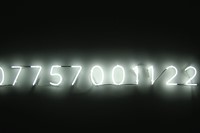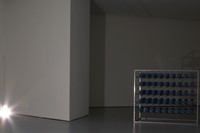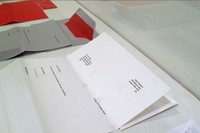For her 2007 degree show at the Slade, Katie Paterson famously displayed her mobile phone number in neon on the gallery’s wall inviting visitors to call the number and listen to Vatnajökull, Europe’s largest glacier.
For her 2007 degree show at the Slade, Katie Paterson famously displayed her mobile phone number in neon on the gallery’s wall inviting visitors to call the number and listen to Vatnajökull, Europe’s largest glacier. This work became so popular that over 10,000 people from 47 countries called the number. Since then Paterson has gone on to exhibit her work globally – in London, New York and Vienna. This month sees her biggest solo show to date and first in Asia, which will be taking place at PKM and BBM Gallery, Seoul. Works on show will include History of Darkness – an archive of darkness from throughout the Universe; Light Bulb to Simulate Moonlight – spectral measurements of moonlight, applied to create a light bulb; As the World Turns – a record player which rotates in synchronisation with the earth; and The Dying Star Letters – a series of letters which proclaim stellar deaths, among other works.
Here on the week of the show opening we speak to Paterson about her interest and fascination behind science and astronomy.
It is hard to classify you into any one role, how would you describe your occupation and what you do?
My artwork is mostly conceptually orientated, it spans many mediums and disciplines and often involves nature, ecology, geology and cosmology. I am a bit like a magpie, collecting and piecing together ideas from a multitude of places. The imagination always plays an important role.
Please explain your interest and fascination in science and astronomy?
I’ve always had a curiosity about our planet and universe, which has developed more and more over the last 10 years or so. I’d say my first encounter with really thinking about space begun in Iceland. I was overwhelmed by the scale of the sky, the changing light, and the energy of the landscape. I began to reflect more and more about our connections to the planet and the cosmos at large. As human beings we are not apart from nature, we are nature – it sounds obvious, but we are made of atoms like everything else. It’s very easy to forget this.
In astronomy I can seep myself in ideas about the vastness of time and space – deep time, anterior time - and questions about being. My fascination with space also applies to space on our human scale, from the micro world of grains of sand, to galaxies that have collided into one another millions of years in the past.
What are you most looking forward to about your show at PKM and BBM?
I’m really excited to have my first solo show in Asia, which will be the largest show in my career so far. The exhibition takes place on three floors and shows nearly everything I’ve made. I’m interested to see how the works refer and relate to one another. I’m really happy to be working with PKM Gallery and BBM, and for a new audience and culture to experience my work. I’m also very excited to explore Korea for the first time.
Will there be any new works exhibited?
Yes, I’ve made a new archive of Vatnajökull (the sound of). In this piece people from all over the world could dial a telephone number to be connected to a glacier in a remote part of Iceland, and listen to the sound of its melting. I’ve made a special archive for PKM, with the neon sign of the phone number, photographs of the place and a book which lists the 10,000 phone-numbers that called. When I was compiling the book, I was astonished to find that people from far-reached places like Samoa were calling.
I’m also going to be exhibiting a new piece As the World Turns, a record player which rotates in time with the earth – it turns one revolution in 24 hours. It plays Vivaldi’s the Four Seasons, and in PKM Gallery it will play the Spring concerto. It moves so slowly it isn’t visible to the naked eye, but it is still turning, and it makes a very peculiar sound.
What is the intention behind your works and what do you hope viewers get from them?
Actually there is no intention behind any of my artworks, and I purposely don’t attempt to provoke a particular kind of response. It’s very important to me that I have no idea what is coming next, or what the reaction or experience will be. I like to think that my artworks can function in a way like the ‘butterfly effect’, rippling and extending out.
Do you see yourself continuing to expand on your current discoveries and work in the future?
Yes, definitely. At the moment I’m artist in residence in UCL’s Department of Physics and Astronomy, which allows me to sit in on seminars and lectures and join in debates with the Group. I’ve been absorbed in so many subjects ranging from the Sagittarian Stream to the earliest objects in the Universe. I keep returning to the idea of dying stars. The more I learn about their life and death cycles, and our intimate connection to these long-gone events, my fascination deepens. I’m writing a series of letters which declare their deaths, and they are arriving to PKM Gallery day by day.
Text by Lucia Davies
Katie Paterson at PKM and BBM Gallery, Seoul runs from 24 March – 6 May.



